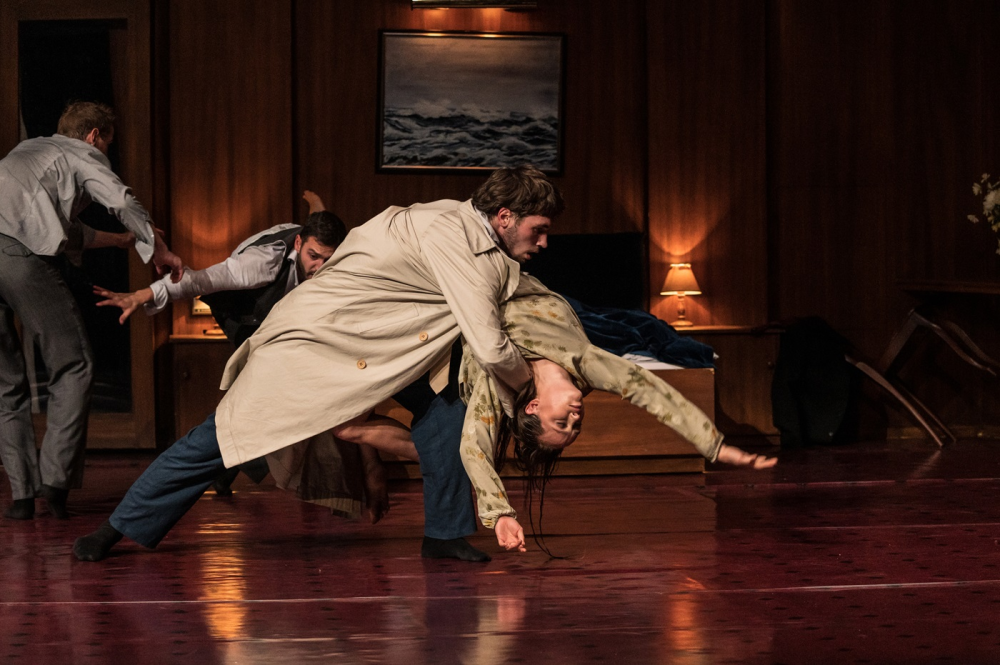Kiri Te Kanawa Theatre, Aotea Centre
Auckland
22 - 24 March 2024
Reviewed by Jenny Stevenson

It is best to leave your logical mind at the door in order to fully experience the maelstrom of sensory overload that characterises the two Diptych dance-theatre works created by Belgian choreographers, Gabriela Carrizo & Franck Chartier for their company Peeping Tom. As the name of the company suggests, the audience is viewing what they shouldn’t: peering into the cloistered confines of an interior world from the outside, sometimes aghast at what is being observed, but not quite able to look away. What goes on behind closed doors takes on a nightmarish quality exposing the foibles of a group of characters who enact strangely prescient scenarios and stylised rituals.
The two works, The Missing Door created by Carrizo and The Lost Room by Chartier were originally made for Nederlands Dans Theatre in 2013 and 2015 respectively. They now form part of a Triptych with a new work The Hidden Floor added in 2020. In the works the choreographers are attempting to “break the linearity of time by mixing the past, the present and the future” and they often employ a cinematic approach to achieve this.

Photo by Andrea Avezzu

The Missing Door comprises a set of five doors in a room where a man is dying and a woman is already dead. The action all takes place “in the twilight zone between life and death.” The Lost Room is enacted in a ship’s cabin with a large bed and as the group of characters enter and exit in various states of delirium or in thrall to their preconceived pathways, the concepts of “freedom and entrapment go hand in hand.”
The dancing is quite extraordinary, especially since it is somewhat removed from our own aesthetic, here in Aotearoa. The coiled energy embedded in the dancers’ bodies erupts into moves that are totally unexpected, propelling the dancers into astounding leaps, shapes or percussive juddering. At other times they arch effortlessly in silky smooth lifts and dives or are manipulated like puppets with frozen limbs. They occasionally sprawl in seats, on beds or on the floor in ungainly positions not usually associated with dance, giving an earthy realism to the work.


A beautiful and sensuous pas-de-deux performed in the midst of the surrounding mayhem is one of the highlights for me, as is the heart-beat segment where the dancers are still, with only their chests rising and falling in time with the sound of a beating heart. The eight performers, Konan Dayot, Fons Dhossche, Lauren Langlois, Panos Malaktos, Alejandro Moya, Fanny Sage, Eliana Stragapede, Wan-Lun Yu and a surprise guest appearance by New Zealand dance legend, Michael Parmenter as “Figurant” are a joy to watch. They hail from many different parts of the world and are equally as skilled in acting as they are in dance. Their presence, “in the moment” as performers who are steeped in the minutiae of their chacterisations, is their real strength.
Illusion and obfuscation cloud the lens of our perception in both works. Several dance phrases might happen simultaneously onstage, so that the eye is forced to dart from one to another dancer or group of performers. When you look back, the original dancer might have disappeared only to pop up again disquietingly, in a new location. It is an unsettling technique but succeeds in keeping the audience fully engaged. The illusion of a disembodied head is particularly chilling artifice, as the head appears to squawk in distress as it pops up on the bed or is carried around the room. Macabre in the extreme.

Photo by Maarten Vanden Abeele

A team of five composers: Raphaëlle Latini, Ismaël Colombani, Annalena Fröhlich, Louis-Clément Da Costa and Eurudike De Beul have created the extraordinary score which is such a riveting component of both works. Shockwaves ripple through the audience in response to the clashes, bangs and searing sounds when they occur. The sets designed by Gabriela Carrizo and Justine Bougerol form the intricate interiors that play such an important role in facilitating the action. Doors open and shut at random intervals or at the lift and lowering of a leg, lights flicker and fixtures move. A cupboard full of people spills out, the dancers’ limbs splayed or they are hurriedly pushed inwards, toppling over each other in their haste.
As the action begins to wind down and resolve, Parmenter’s role is symbolic – bent over at the waist, carrying a pile of suitcases on his back, he walks slowly and painfully towards the bed. There he dumps the suitcases and begins to weep, uncontrollably as the work slowly finishes. However, the work continues to resonate long after the curtain-calls end.

Photo by Virginia Rota

